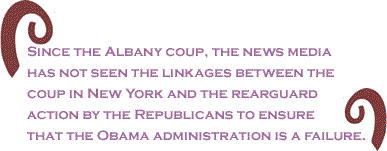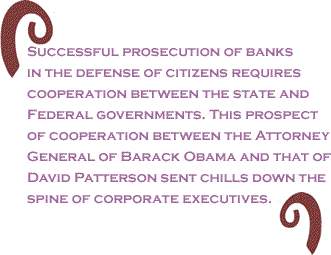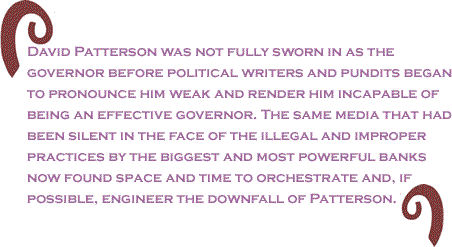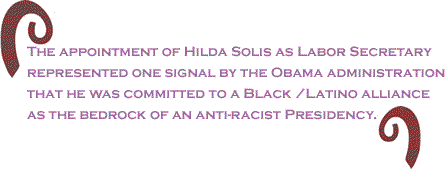
|
|||||||||||||||||||||||

|
|

Custom Search
|
|
 |
|
Introduction On June 9th, 2009, Headlines all across New York state… “Coup in Albany.” This headline was in response to the events of the previous day when two members of the State Senate from the Democratic Party switched sides and gave the majority in the New York State Senate to the Republicans. From June 8 to June 30 at the time of this writing all business in the New York Senate was deadlocked. A coup d’etat is associated with the seizure of political power by unconstitutional means. In most coup d’etat, it is the military that is behind the armed seizure of power. Behind the military are also social and political forces that cannot come to power by normal electoral means. In this June 8, coup it was a parliamentary coup. A billionaire, Tom Golisano, who could not win elections staged the moves to remove the Democratic State Majority leader Malcolm Smith from his position. Malcolm Smith had become majority leader in 2009. It will be the main argument here that in the background of this parliamentary coup d ‘etat thus far are the bankers, speculators, and billionaires who want the working people of New York to face the brunt of the economic crisis. They need the legislative branch of New York to be in a state of gridlock so that the push for financial regulation does not fully reveal the reality of what took place on September 15, 2008. [1] While the issue of reform of the state senate was the ostensive dividing line between the two Democrats who switched sides, a far more burning question was the future of the democratization of the structures of state and city governments in the changed political environment (explicitly - the meaning of an Obama Presidency for the old politics of patronage). In the 2009 budget discussions in the state, the projections for recovery were all based on the belief that the economic depression would end after three of four quarters. In the past, the New York State coffers benefited from the speculative bubbles of Goldman Sachs and other speculators on Wall Street. New York State had derived at least 20 per cent of its revenue from financial institutions in the period of the inflated stock market boom. The decision by Goldman Sachs and Morgan Stanley to become bank holding companies in September 2008 marked the end of an era in politics and the end of a model of securities and investment that dominated New York since the depression of 1933.
Prior to the New Deal it was the state of The New York that pioneered many of the progressive legislation for working people during the governorship of Al Smith. [2] State legislators in New York and the Attorney General can bring law suits against Wall Street (with powerful instruments such as the Martin Act of 1921) and this palace coup d’etat is one salvo in a larger evolving struggle of a wounded class that wants to recover the kind of power that they held under the Bush administration. Even though Gov. David Patterson had been one of the first to offer support to the American Insurance Group (AIG) back in September 2008, the depth of the crisis is so severe with a looming commercial real estate meltdown that the financiers want a government in New York that will not hesitate in dishing out the costs of the crisis to the working people. Description of the Coup by the media “Chaos reigned in Albany on Monday night after Republicans seemingly pulled off an unprecedented midsession coup to gain control of the chamber.” This is what the New York Daily News screamed on June 9 in giving coverage to the alleged take over of the New York Senate by the Republicans. As in the unconstitutional seizures of power, sections of the media endorsed the take over even before the consolidation of the seizure of power. In short, conservative newspapers gave legitimacy to the coup while it was still in the making. In broad outlines here is how the press reported the take over. “The GOP flipped two Democrats to shift power to their side, making one of them, Pedro Espada Jr. (D-Bronx), the temporary Senate president. After weeks of intense discussions, Espada and Sen. Hiram Monserrate (D-Queens) agreed to side with Republicans in what they are calling a new bipartisan coalition to run the Senate. The two said they will remain Democrats. Republican Minority Leader Dean Skelos was installed to his old post as majority leader. [3] Coup and Musical Chairs. Within a week state senator Hiram Monserrate again switched to say that he will vote with the Democratic Party. This left the New York State Senate gridlocked with 31 representatives for the Republicans and 31 for the Democratic Party. For two weeks there has been behind the scenes and on-camera jockeying and scrambling with the spectacle of the Democrats seeking to reverse the coup while the Republicans sitting back ensuring that even if the coup fails, the New York Senate will be paralyzed and not able to do business. The New York State Senate has not been able to act on a number of legislation, including: - Reauthorization of mayoral control of education in the city. - Legalization of gay marriage. - Democratic-sponsored ethics reform. - Changes in city rent laws, reauthorization of county sales tax, etc . When the full information on the character of Pedro Espada began to emerge, the press called him a ‘flawed’ character but failed to investigate the deeper implications of what a coup meant for US politics. Anger was not enough From the day of the coup, Governor David Patterson rushed back to Albany from Syracuse and called the coup “an outrage” and “despicable,” because it comes when a host of issues were unresolved. “Once again Albany’s dysfunction has raised its ugly head,” stated the Governor.
Paterson vowed, “I will not allow this to go on much further” while acknowledging he has no real say in the matter. Pedro Espada said he switched allegiances because the Democrats failed to enact most of the reforms they promised after taking control for the first time since 1965. It is necessary to grasp the full essence of this coup in the two crucial lines. (a) Upstate billionaire Tom Golisano helped broker the coup. He was upset at a state budget that raised taxes and fees by $8 billion and (b) “Espada would be acting governor if anything happened to Paterson.” It is the opinion of this author that the Republicans are in a state of panic. It is not by accident that the administrative changes that the Republicans wanted did not relate to the wishes of voters, but to the so called, reform of “administrative budgets.” Republicans need to have the funds divided equitably so that their party machinery can be oiled with staffers from the rural areas. The fact that Patterson remained angry after two weeks exposed the fact that he did not consider telling the voters the real reasons for the coup. David Patterson had deserted the ordinary voters by making steep cuts in the budget that affected working class families. At the same time Patterson had refused to consider a millionaires tax on the wealthiest of New York residents. Background to the coup against David Patterson and the Democratic Party in New York State The historic events of September 2008 had given tremendous urgency to the question of the balance of political forces inside the United States. Nowhere in the United States is the power of the financial lobby more evident than in the state of New York. One only has to read of the history of Goldman Sachs over the past 140 years to understand the political power of the banks and financial institutions. [4] New York is the state of Wall Street, the Headquarters of the banks, insurance and media houses. The former Governor of New York, Elliot Spitzer had fallen in 2008, in part because of his own masculinist urges, but hidden from the news was his challenge to the Bush administration over the role of the banks and the need for regulation of the banks. Shortly before he was exposed by the federal agents, Elliot Spitzer had written an article in the Washington Post, February 14, 2008 arguing that,
Spitzer finished his editorial by warning that,
Not only did the federal government assault state legislators but within weeks after writing this editorial, Spitzer himself was gone as Governor of New York. As Greg Palast noted as far back as March 2008,
Elliot Spitzer had filed a law suit against the Bush administration upholding the right of the states to sue national banks for violation of state consumer protection and fair lending laws.
The elevation of David Patterson to the position of Governor moved the issue of New York state regulation of Wall Street to a new level. Here was a Lieutenant Governor from a progressive background who became governor in one of the most powerful states in the same year that Barack Obama became the President of the United States. Successful prosecution of banks in the defense of citizens requires cooperation between the state and Federal governments. This prospect of cooperation between the Attorney General of Barack Obama and that of David Patterson sent chills down the spine of corporate executives. Using Poll Data to diminish David Patterson David Patterson was not fully sworn in as the governor before political writers and pundits began to pronounce him weak and render him incapable of being an effective governor. Week after week the media rolled out polling data to argue that Paterson was indecisive and effective. The same media that had been silent in the face of the illegal and improper practices by the biggest and most powerful banks now found space and time to orchestrate and, if possible, engineer the downfall of Patterson. When the full effects of the financial bubble became evident, the same conservative media criticized Governor Patterson that he was not going far enough to call on the workers to sacrifice. Governor Patterson had called for ‘shared sacrifice’ in the face of the budget cuts but the media wanted only one section of the population to sacrifice, -that is the working people. Indeed, Patterson mouthed the same arguments of Michael Bloomberg by claiming that any increase in taxation on billionaires would result in New York’s multi-millionaires and billionaires fleeing the state. But the issue of the millionaires’ tax was not a problem for New York, it was a national issue. Before he became Governor, Patterson had been identified with the progressive causes in the state, ban on assault rifles, repealing the Rockefeller drug laws, same sex marriage, rights of tenants, educational reform and the rights of workers. When he did occupy the position Governor Patterson reneged on the most important of these platforms, especially the support for the working peoples and trade unions in the State of New York. Notwithstanding his reversal on the substantive questions, the banking and financial sector were not content with the make up of the New York government, especially when all governments and economic enterprises are lining up for hand-outs from the federal government. Patterson became Governor when the solid lines of ethnic politics in the state of New York had been thrown into an unprecedented upheaval by the election of Barack Obama and the departure of Hilary Clinton from the Senate. Senator Charles Schumer, the titular head of the financial wing of the party was scrambling for political cover in the face of the indictment of Bernard Madoff and the fall of Lehman Brothers. Former governor Mario Cuomo was even more silent with his son, Attorney General Andrew Cuomo remaining in the shadows when his office should have been very vigorous in leading the charge to clean up Wall St. The Andrew Cuomo faction of the Democratic Party had carried the Elliot Spitzer case to the Support Court to show that the Bush administration erred in shutting down New York’s efforts to question banks about predatory lending practices. Pensioners and other citizens wanted the office of the Attorney General to be more aggressive against the banks. (NB. On Monday, June 29, the U.S Supreme Court voted to support the outstanding Spitzer case which was brought forward by Andrew Cuomo- - in Cuomo v. Clearing House Association, upholding the right of the states to sue national banks for violation of state consumer protection and fair lending laws). Instead of intensifying efforts investigating fraud, some of the elements around Andrew Cuomo spent their time building relationships in preparation for a primary fight against David Patterson in 2010. The Irish section of the party leadership was divided with county factions hedging in the event that the coup succeeded. In this situation, it was the black sections of the Democratic Party that became a force in the battle to reverse the coup. New York politics had always been tribal but the ‘white’ tribe always believed that the blacks could be manipulated.
Black voters had been the most loyal of the Democratic Party in New York ever since blacks moved from supporting the party of Abraham Lincoln in the thirties. The old alliances between David Dinkins (former Mayor of New York City), the elder Basil Patterson (former Secretary of State of New York), Charles Rangel (Congressman from Harlem and Head of the powerful Ways and Means Committee) and Percy Sutton (entrepreneur and former Manhattan Borough President) had guaranteed a solid base of support from black people for the Democratic Party. Behind the party stood one of the most progressive sections of the population that inherited the legacy of Harlem radicalism, the street smarts of Malcolm X and the Civil Rights traditions. After the election of Obama in November 2008 the Democratic Party bosses made up of ethnic leaders from the Irish, Italian, Jewish and other ethic alliances now had to choose between a solid base of black support aligned with Latinos or an alliance with the Republicans, premised on the deepening divisions between blacks and Latinos. David Patterson was not passive in this struggle over his governorship. In an attempt to curry favor with the county bosses, Governor Patterson named, Representative Kirsten Gillibrand, a 42-year-old congresswoman from upstate as the replacement for Hilary Clinton. Kirsten Gillibrand who is known as a conservative Democrat came from a family that was linked to county operatives throughout the state of New York. Naming Gillibrand emerged after a messy back and forth between the office of David Patterson and Caroline Kennedy. This appointment of Gillibrand was a pre-emptive effort to thwart an open alliance between local party operatives to support another democrat in the primaries against Patterson in 2010. Bloomberg and Republicans watching At the level of the mayoral contests the hierarchy of the Democratic Party was always more relaxed with Republicans in charge of New York City than with a Black /Latino alliance at City Hall. So though New York City is predominantly Democratic, Republicans continue to win the race for Mayor. David Dinkins was not in the job long enough to clean out the entrenched real estate interests and the minions of Robert Moses. Moses 1888-1981 city engineer dubbed ‘master builder ‘ of New York City for over five decades - had been “highhanded, racist and contemptuous of the poor.” [6] After David Dinkins, the election of Rudy Giuliani as Mayor brought out the full force of conservatives, bankers and the counterfeit security firms. Giuliani was the mayor when there were police shootings of unarmed citizens took place, crowned with hail of bullets which killed Amadou Diallo. There were other repressive highlights such as the attack on homeless persons, the sexual torture of Abner Louima and the killings Patrick Dorismond. Bloomberg succeeded Giuliani and maintained the same alliance of conservatives even while presenting himself as a great philanthropist. Both Bloomberg and Giuliani justified their activities in the name of “seeking a safer, cleaner and more hospitable New York City.” To cover up this conservative approach to urban development Mayor Bloomberg has used his billions to establish charitable foundations to generate support among blacks and Latinos.
It was under Giuliani as a Republican Mayor and with a Republican Governor in Albany that NY state law took control of schools from parents and gave control to the Mayor. The 2002 state law granted New York City’s mayor control of its public schools. This state law was up for renewal at the end of June and if not ratified in a resolution of the coup, the whole system of patronage and support for private capitalists in education will be thrown in disarray. The effort of Mayor Michael Bloomberg to seek a Third Term as Mayor is part of the larger strategy of the National Republican party to hold on to one level of power in an era when there are calls for more oversight of the economy by working peoples. Developers, real estate magnates, bankers and political entrepreneurs who were the ones benefiting from the predatory lending under the Bush administration need an ally at Gracie Mansion in New York to ensure that the stimulus money from Washington goes into the coffers of the same forces that continue with the vision of Robert Moses. Silencing Charles Rangel Because of the old alliance between the Basil Patterson, David Dinkins, and Charles Rangel, the divisions in the Democratic Party had focused on weakening Charles Rangel when he became the chairman of the House Ways and Means Committee. In the past, this Ways and Means Committee in Washington had been one of the most powerful arms in the US government in its ability to change the tax code and to initiate the imposition of new taxes on the rich. It should be noted that from Press reports the key player behind the June 8, 2009 New York Coup, Tom Golisano, had been upset over plans to raise taxes on billionaires. As a Congressman from Harlem, Rangel had turned his back on the progressive traditions of Adam Clayton Powell and had sought to conciliate the billionaires. He had given the bankers and their philanthropic front, the Robin Hood Foundation (with trustees such as Lloyd Blankfein of Goldman Sachs), free rein within his congressional district to experiment with urban pacification and diversion. Founded in 1988 as the brain child of the same forces that developed hedge funds, credit default swaps and derivatives, in 2006, the board of directors included such names as Jeffrey Immelt, Harvey Weinstein, Marie-Josee Kravis, Lloyd Blankfein of Goldman Sachs, Richard S. Fuld, Jr. of Lehman Brothers, and numerous luminaries form the banking sector. One author termed these bankers the Emperors of Benevolence. Once Charles Rangel made an alliance with the friends of Robert Rubin and Goldman Sachs he lost the support of the ordinary voters in his district and silenced himself in national politics. Rangel had related his version of rags to fame in his book, And I Haven’t Had a Bad Day Since From the Streets of Harlem to the Halls of Congress, but his story did not clarify how he became the front for the bankers. Nor did the book reveal his subservience to the Bill Clinton faction of the Democratic Party.
Once Rangel became a force in Washington, there were efforts to unseat him. This was manifested in the ethical questions over the renting of 3 apartments on the cheap. But the media furor over his ethical lapse in the renting of apartments was itself part of a cover up to overshadow the alliance between Charles Rangel and the Robin Hood Foundation and the massive gentrification that Rangel had supported in his district. Hence, when the media and his opponents went after Rangel in the summer of 2008, Rangel had very little support in the progressive communities. On the weekend after the collapse of Lehman brothers in September, the leading editorial in the New York Times was not about the failure of one of the oldest investment houses but calling out Rangel for not paying US $5,000 in taxes. Although House Speaker Nancy Pelosi reconfirmed Rangel as the Chairperson of the Ways and means Committee in the New Congress of January 2009, the campaign against Charles Rangel had rendered him impotent at precisely the moment when the Federal government needed a robust Ways and Means Committee to rope in the excesses of the billionaires. With David Patterson encumbered and Rangel weakened, the Republicans needed a win in the evolving political struggles. Tom Golisano – coup maker and class warfare? After the elections in November 2008, the Democratic Party in New York State won control of the Senate for the first time in 40 years. This victory elevated Malcolm Smith from Queens to be the Senate majority leader. Followers of State politics were aware that Malcolm Smith and David Patterson did not have the political spine and the experience to match the ethnic barons and the sharks that functioned as lobbyists. Joseph Bruno (R), the last substantive Senate Majority leader had ended his career in disgrace. The election of Barack Obama as President and the economic crisis meant that the Republican Party was threatened in all the traditional upstate counties. Republican Control of the Senate committee had been the vehicle for the distribution of patronage all across the state of New York. One visible sign of this patronage was the building of prisons all across the state of New York. Thomas Golisano, from Rochester, in upstate New York was pictured the day of the coup with Sen. John DeFrancisco (Republican from Syracuse). The media represented State Senator John DeFrancisco and Tom Golisano as the brains behind the coup. Golisano had been building a high profile image of himself in the state of New York as a philanthropist. Similar to the big men of Goldman Sachs and their alums, Golisano had been giving money to institutions of higher learning in New York in order to purchase political legitimacy. He ran for governor of New York in 1994, 1998 and 2002 as the candidate of the Independence Party and each time he lost. During the time of the Barack Obama campaign he disbursed funds to sections of both parties to elevate his organization to be a king maker in New York politics in the absence of Hilary Clinton and Terry McAuliffe. On May 15, 2009 Golisano proudly exposed the opposition of the bankers and billionaires to the taxation measures of the state and federal government by announcing that he was moving to Florida to escape New York state taxes. Despite the change of residence, Golisano appeared on the day of the coup, prominently posing with the coup makers. Golisano was taking center stage in the class warfare that was now raging across the United States in the face of the depression. In Maryland, millionaires were opposed to the taxes and like New York were now responding. But the issue of taxes masked a far greater problem; the pre emptive planning by billionaires and banks who are already planning to shift the blame on to the people, the real economy and to Obama’s attempt to regulate them when the next downturn hits and they will once again use their lobby to ask for more government bailout money. Pedro Espada and the old playbook At breakfast on Wednesday August 27, 2008, some of the Clinton supporters of the Democratic Party New York and California delegations met at a hotel in Denver on the sidelines of the Democratic Party convention. This meeting brainstormed about the Latino support for Hilary Clinton in California and in New York and the role that this faction would play in the event of an Obama defeat and Hilary was committed to running in 2012. It was a meeting where the conservative Latino factions of the party reinforced their view that they would not want to partner with the blacks in the Democratic Party. These conservative factions would prefer to ally with the Republicans than with the progressive forces in the Democratic Party that wanted to make immigration reform real.
Barack Obama cut the rug from under their feet after his election, firstly by winning the election and secondly, by placing progressive Latinos in his cabinet. The appointment of Hilda Solis as Labor Secretary represented one signal by the Obama administration that he was committed to a Black /Latino alliance as the bedrock of an anti-racist Presidency. While walking a tight rope with elements such as Tim Geithner and Lawrence Summers (Robin Hood Foundation types) in his cabinet, the same leader announced, on May 26th, that he would appoint Sonia Sotomayor to the Supreme Court to replace Justice Souter. With Solis from California and Sotomayor from New York, Barack Obama broke up the playbook of those at the breakfast who had wanted the black Latino divisions to paralyze the Obama administration. Pedro Espada was re-elected to the New York State Senate in 2008 for a seat in the 33rd District in New York. This is the Bronx, the seat of hip hop, revolutionary Puerto Ricans and a long tradition of radical politics. Espada emerged from a political family and has ridden the waves of City and State politics. The Republicans had done enough research on him to understand his strength and weaknesses in order to plan the coup. Media reports indicate that Golisano continues to lean heavily on Espada despite efforts by his constituents and sections of the Democratic Party in New York City to broker a compromise. Politics is about patronage and power in New York State and the coup plotters and their opponents are not willing to go to the voters to explain what is at stake. Espada is currently the Vice President Pro Tempore for Urban Policy of the State Senate of New York. In the midst of the depression, this is already a crucial position of patronage for the distribution of monies from the federal government. But from all accounts, Espada is after bigger and better positions in the gravy train. In throwing his support behind DeFrancisco and Golisano to appoint Republican Dean Skelos as Majority Leader, Espada has assisted the citizens to see the rottenness of state politics in New York. After reading the career of Espada it became clear that the Republican had no respect for the intelligence and integrity of the citizens of New York. If the coup stands, Espada will be next in line to be Governor. As long as the issues of leadership are in dispute, the Republicans can be assured that the major and fundamental question of regulation of the financial barons will be off the table. Moreover, the confusion in Albany reinforces the call by Michael Bloomberg to the Wall Street forces that his tenure in office is necessary to protect their interests. Is the White House paying attention? Progressive forces have to play close attention to the coup in Albany. Progressives and informed citizens must understand that this paralysis in Albany is a dress rehearsal for a possible similar paralysis in Washington D.C. It was reported that before the coup President Obama called Rep. Steve Israel, a potential primary candidate for the US Senate to request that this person not contest the primary election against incumbent Kirsten Gillibrand (for Hilary Clinton’s Senate seat). It was also reported that Vice President Biden spoke to Rep. Carolyn Maloney (D-NY), urging her to not run in the Democratic primary for Senate against Gillibrand. Both Israel and Maloney represent two different sectors of the ethnic alliance of the Democratic Party in New York State. To demonstrate that the Party was not united, one political operative, Joe Trippi, made a public appeal to Maloney to defy Obama and run in the primary against Gillibrand.
What has been most revealing is the continued silence of Andrew Cuomo. It was expected that as Attorney General of the State of New York, he would be standing beside David Patterson, denouncing the coup and pushing for prompt corrective action to ensure that the investment firms account for the loss of millions by pensioners. Although the National Republican party is in disarray, the fragile economic situation opens room for mischief by the right wing. Conclusion. Since the coup, the news media has not seen the linkages between the coup in New York and the rearguard action by the Republicans to ensure that the Obama administration is a failure. Coups should not be dismissed by the left and progressive forces. The conservative news media and other far right voices have engaged in hate and fear mongering since November 2008. They have fanned the fires of hatred while encouraging their faithful to arm themselves. It is important for non New York residents to grasp the impact of this coup, its genesis, the players and the implications for the balance of power in Washington D.C. That a non elected billionaire was central to the coup plotting is essential in grasping the links between the coup and the financial crisis. The non elected billionaires are seeking to ensure that no one debates about what the banks did with the last money they received, how they have hindered recovery of the real economy by taking in tax money, going after the taxpayers for the money they owe to the banks (getting paid twice), how they are hoarding money as opposed to investing it back into the real economy and of course how we should not talk about changing the role of banks in relation to healthcare, education and employment.
While citizens were still wondering about the parliamentary coup in Albany, the military in Honduras carried out a putsch against a constitutionally elected leader. The authors of this military coup have strong links with the military establishment in the United States. The Obama administration has tepidly condemned the Honduran coup. The Obama administration need to outline to citizens the dangers of unconstitutional political change and expose those forces in the US military with ties to the Honduran military. What are the possible lessons for Barack Obama? What can we learn from the old ethnic politics and conservative forces? Firstly, we have learned that the old politics of patronage and power is being discredited and that both David Patterson and Barack Obama must go back to the people to derive any legitimacy. The working people are ready for health care, for books not jails and for the use of federal money to support working people. Secondly, we have learned that the left in New York must pay closer attention to all levels of politics and become more engaged. Remnants of the black liberation movement have not yet grasped the full extent of the crisis and need to become more engaged to advance an agenda that pushes the Obama and Patterson administration to serve the people.
Fourthly, even at this late hour there must be an intensification of the popular campaign to expose Mayor Bloomberg and his plan to gain a Third Term. Michael Bloomberg is a place holder to ensure that the developers, real estate magnates, bankers and political consultants receive the bulk of the monies to be expended by the Federal government. Fifthly, the progressive forces in the country must oppose all forms of unconstitutional change of power. Blacks and Latinos, in particular must hold leaders accountable and ensure that those who are bought by Republicans and billionaires do not remain as elected representatives. Even while standing aside from electoral politics the left and the peace movement must denounce the coup. The military coup in Honduras has made this denunciation more urgent. This writer as a political scientist is going on record to denounce the coup in Albany as well as the military coup in Honduras.
The bankers and big capital brought down Elliot Spitzer. When they were caught in the open they placed Bernard Madoff in detention as a sacrificial lamb in order to divert attention from the biggest scandal of the collapse of Wall Street. Presently, the bankers are intent on paralyzing New York in order to weaken if not remove David Patterson. These are warm up exercises for the big battle to cripple the Obama Administration. At this moment the paralysis requires people’s intervention. But the people cannot intervene unless Patterson understands the long arms of the Goldman Sachs and the Robin Hood Foundation. BlackCommentator.com Guest
Commentator, Dr. Horace Campbell, PhD, is Professor of African American
Studies and Political Science at Syracuse University in Syracuse
New York. His book, Rasta and Resistance: From Marcus Garvey to Walter Rodney
[1] It was September 15, 2008 when the entire financial system was hours away from collapse. The full disintegration of the investment houses occurred a few days later. Lehman Brothers collapsed and the Federal government had to pump billions to salvage AIG. [2] Alfred R. Smith (D) was dominant in New York State politics during the roaring twenties. He was elected Governor in 1918 lost the new election and later won again in 1922. Under his leadership New York increased support for workers by supporting laws addressing Workmen’s Compensation, Women’s pensions and child labor laws. [4] For an interesting account to understand how Goldman Sachs engineered every major market manipulation since the great depression of 1933-1945, see Matt Taibbi, The Great American Bubble Machine, Rolling Stone Magazine, July 2, 2009 [5] Elliot Spitzer, “Predatory Lenders' Partner in Crime, How the Bush Administration Stopped the States From Stepping In to Help Consumers, Washington Post, February, 14, 2005, page 25 [6] Younger residents of New York need to know the history of the engineer Robert Moses, see Robert Caro, The Power Broker: Robert Moses and the Fall of New York, Alfred Knopf, New York 1974 [7] The State Banking Committee has powers over certain activities of Wall Street. The work that was done to expose how the sub prime mortgage and predatory lending affected black and Latino citizens must be publicized across the nation. See the work of New York State on, A Perfect Storm: Easy Money and the Mortgage Meltdown The Subprime Mortgage Crisis in New York |
|
Any BlackCommentator.com article may be re-printed so long as it is re-printed in its entirety and full credit given to the author and www.BlackCommentator.com. If the re-print is on the Internet we additionally request a link back to the original piece on our Website. Your comments are always welcome. eMail re-print notice
If you send us an eMail message we may publish all or part of it, unless you tell us it is not for publication. You may also request that we withhold your name. Thank you very much for your readership. |
|
| |
|
| July
9, 2009 Issue 332 |
|
| Executive Editor: Bill Fletcher, Jr. |
| Managing Editor: Nancy Littlefield |
| Publisher: Peter Gamble |
| Est. April 5, 2002 |
Printer Friendly Version
in resizeable plain
text format or pdf
format. |
| Frequently Asked Questions |
 |

|
 |
 |
 |
| |
| |













































